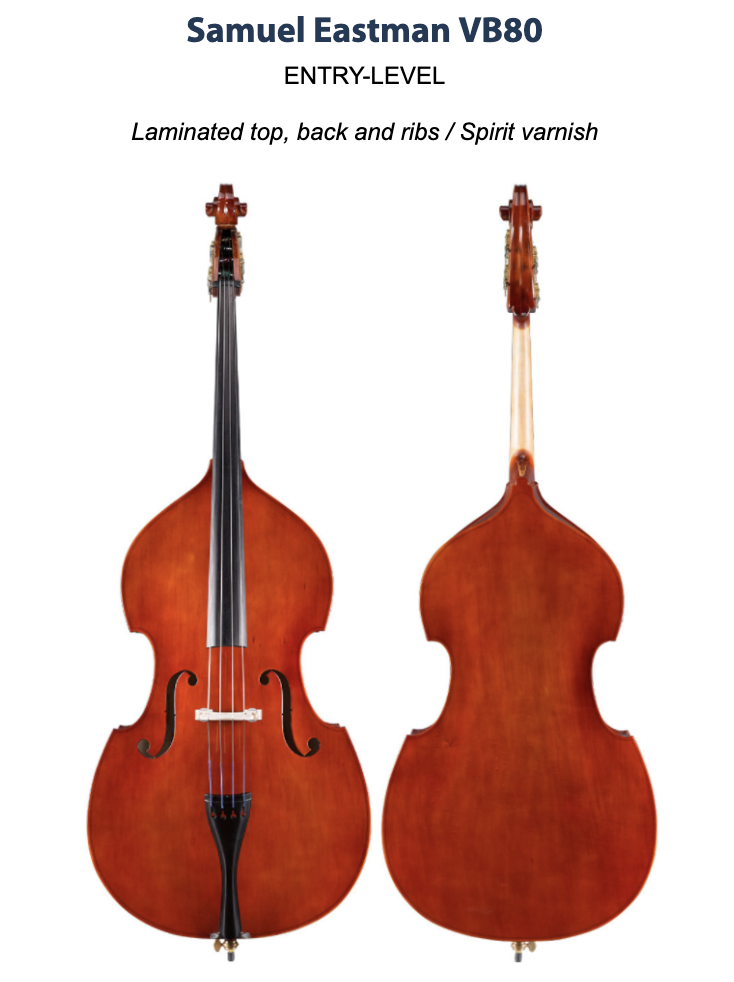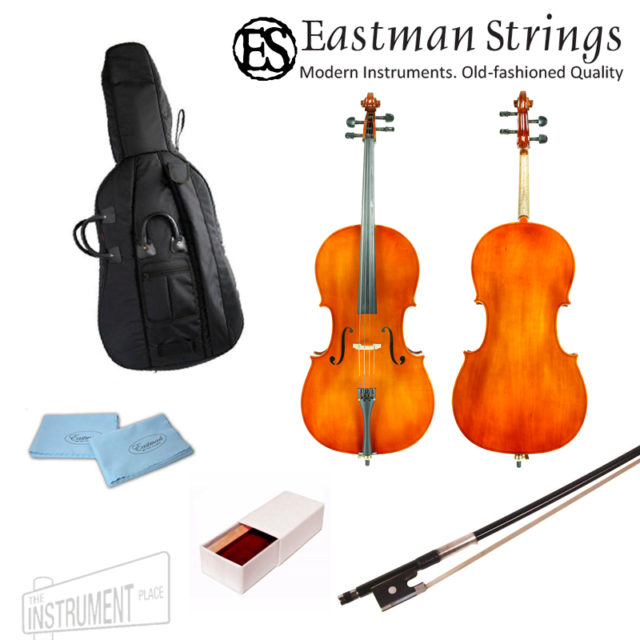Introduction
The string bass or double bass has its roots in the 1500s, when it was developed in Italy’s Brescia and Cremona regions to complete the lowest part of the register in the violin family, just below that of the cello. It has many names by which it has been known over the years, including contrabass, upright bass, acoustic bass, double bass, and standup bass. In an orchestra setting, it is known as the string bass and inhabits the same register as the tuba and the timpani.
Up until the early 20th century, the upright bass had just three strings and the player tuned it however best suited their style and the music they were performing. A five-string bass was first used in Austria and Germany in the 1600s.
The fret-less string bass is so common today that some bass players are surprised to learn that originally the instrument was fretted exclusively. In the early days, players wrapped gut around the fingerboard to create frets, which made it easier to play notes with accurate pitch. Today you will find that double basses are made exclusively without frets. Bret Simner plays a fretted, 5-string double bass in his TEDx talk below.
Today the string bass has four (or five strings) made of steel and there are two basic tunings for it: classical and solo. Classical basses are tuned to E, A, D, and G. When tuned in “solo tuning” the strings are tuned up one whole step to F#, B, E and A.
The modern bass also comes in a wide variety of sizes, all the way from student size (1/10th) to full size (4/4 or 7/8).
Back to topWhich String Bass Should I Choose?
The Orchestra Place requires all students to have an instrument from the teacher-approved brand list to ensure the best experience and sound for the student and the ensemble.
For beginners, we recommend Eastman Strings Student Bass Outfit as the best string bass for quality and affordability.
Samuel Eastman Strings Student Bass
Founded in 1992, Eastman Music Company has established a reputation for their quality, traditional sound, and craftsmanship. Eastman is highly regarded for creating some of the finest instruments and accessories, and stands at the forefront of the creative development and marketing of musical instruments heard around the globe – making the reasonable string bass prices for their products especially attractive.
Back to topHow to Choose the Right String Bass Size for My Child
When selecting a string bass for your child, size is extremely important. The instrument needs to feel comfortable and should not cause strain in the arm or back. If your child feels at ease with their instrument, they will be much more likely to enjoy playing and want to stick with it.
1. Starting Out: 5th grade students should almost always be playing a 1/4 size bass. It’s not too small even for someone 5 feet tall in the 5th grade. Because the reach is challenging for everyone new to double bass, it’s better to have the bass be a little too small than a little too big for elementary school-aged children.
2. Transitioning to Adult Size: Although 1/2 or 5/8 sized basses are available, most students can successfully transition without one, moving from a 1/4 directly to a 3/4 sized instrument. The age at which they do this will depend on when they grow and how big they are. Many students play a 1/4 all the way through the end of 8th or 9th grade before switching to a 3/4 size for high school. Taller students may move to a 3/4 size as early as the 6th grade.
3. When You’ve Stopped Growing: 3/4 size is recognized as a regular size bass for adults. A 4/4 size bass is really considered more of a “jumbo” or “XXL” bass and are mostly used in orchestras, where acoustic volume is very important, and the extra depth can be advantageous for those using E-string extensions for extra low notes.
So don’t be compelled to purchase a 4/4 size bass because you think it’s “better” than a 3/4 size bass, or you believe that you need to have a “full size” bass. From a practical perspective, the selection of accessories is far smaller for 4/4 basses and it’s harder to find cases and strings that are reliably sized for 4/4 basses.
Back to topHow to Buy a String Bass
After a young string bass player has at least a year of experience, buying an instrument is often the best choice, financially and in sense of ownership. Your student has demonstrated their commitment and is ready to maintain and practice on their very own instrument. Since purchasing a string bass is a bigger investment than renting, it’s important to make sure you’ve carefully compared retailers’ inventory, prices, financing options, setup and equipment options prior to buying.
Remember to stick with well-known brands when shopping. String basses are usually made with a spruce top, maple back, and ebony fingerboard, but other materials have also been used in lieu of these. Basses can also be made of plywood laminate or a combination of a carved wood top and laminated back and sides.
- A plywood laminated bass is usually the least expensive and the easiest to maintain, but may develop problems that can be just as expensive to repair as basses of higher quality.
- Hybrid basses made of both plywood and carved wood offer more resonance and better sound quality.
- String basses carved fully out of wood get better with age and develop rich, complex sounds.
Whenever possible, go into an instrument shop and test play the string basses available to find which one best suits you. The feel must be comfortable and the size correct.
Back to topHow Much Should a String Bass Cost?
A student bass will cost roughly $1,800-$3,000. An intermediate bass will cost $4,000-$10,000 or more.
Back to topRent-to-Own or Lease-to-Own String Bass Options
Installment plans are an excellent option if you’re ready to make the commitment of buying an instrument but can benefit from deferred payments. This way, you get the freedom to pay over time, with the ultimate reward of owning the instrument. If you choose a rent-to-own or lease-to-own option, however, it’s important to check the fine print to make sure there are no hidden fees, and you should investigate the cancellation policy as well. Never sign up for a plan that traps you into payments if your child loses interest in playing an instrument. Look also for retailers who offer affordable damage protection during the installment term.
Our instrument supplier, The Instrument Place, offers teacher-approved instruments and one of the best interest-free lease-to-own programs as part of their commitment to getting an instrument in the hands of every person who wishes to play, without it being a financial burden.
Back to topFull Setup and Equipment for String Basses
When comparing retailers, you’re sure to discover a large amount of variation in the set-up, maintenance, and equipment included in your purchase. Your vendor should always offer quality and consistency. Some things to look out for:
- Setup is key. The setup is perhaps the most important thing to consider when looking at a student-level instrument. A poorly set-up instrument can inhibit the student from learning technique and ultimately turn him off from the instrument altogether.
- All strings are not created equal. The caliber and adjustment of a bass’ strings makes a huge difference in sound and feel. Look for new, brand-name strings (e.g. Prelude, Dominant, Helicore) and maple bridges (e.g. Bausch, Despiau, Aubert). Check also for a quality tailpiece with four working tuners (e.g. Wittner). Unpropped or cheap bridges are unacceptable. The nut and bridge should be cut and set to a height that enables comfortable playing, as strings that are set too high may hurt your child’s fingers. Make sure also that the soundpost has been adjusted properly.
- Know your bow. The description “Brazilwood bow with genuine horsehair” may sound impressive, but inexpensive Brazilwood bows are often warped or very weak, and in fact all bows today use genuine horsehair. Look instead for a high-quality fiberglass or carbon fiber bow (e.g. K Holtz or Glasser), or for more advanced players, a Pernambuco wood bow. Any bow your child uses should be easy to tighten and loosen.
- Test the tailpiece. The tailpiece of a bass affects its sound greatly. Make sure the tailpiece has been installed so that it doesn’t create a buzzing sound when played.
- Protection is paramount. Protective cases are extremely important to the health of your child’s string bass; before purchasing, examine the case to make sure that all zippers and latches fasten securely.
- Brand matters. When buying stringed instruments, it’s always best to go with an established instrument brand. Although you may spend more in the outset, a quality brand-name instrument will save you countless maintenance, repair, and replacement costs over time. Look for brands that hand-carve each instrument individually and use materials of excellent quality in grade and preparation.
Recommended String Bass Accessories
When buying a string bass, look for a store that offers all the accessories your child will need in order to best use and maintain it. Look for a protective case, French and German style bows, rosin, name tag, and music stand. You may also want to consider buying a maintenance or care kit, which provides additional cleaning materials and practice aides. Some vendors will include some of these items as part of a bass outfit when you purchase the instrument, whereas others will charge extra.
If you question whether or not a music stand is necessary, keep in mind that it is important to develop and reinforce proper playing posture and technique. A music stand at the right height will help to improve breathing and prevent back aches from poor posture.
The Instrument Place instrument outfits come equipped with everything needed to get started in class, plus a free music stand with every instrument purchase!
Back to topString Bass Maintenance and Care
Like most musical instruments, the string bass requires maintenance occasionally. You should expect a few broken strings from time to time. It just happens with violin family instruments. It is important to know how to care for your string bass.
To keep your stringed instrument in the best condition, please follow these suggestions.
- Do not try and tune the instrument yourself until you are comfortable doing so. It takes a while to learn to do this properly, and if you’re not careful you may damage the instrument, break strings and/or hurt yourself. Take your instrument to the teacher at your next class and have them tune it for you.
- Do not leave your instrument in your car! Intense heat or cold can cause an instrument to come apart or crack, and will definitely cause it to fall out of tune. Also, try to avoid exposing your instrument to sudden changes in humidity. When traveling with your instrument it is always better to keep it in the back seat of your car rather than the trunk.
- Keep your instrument clean. Keep a lint-free cloth inside your case and wipe off all the rosin dust and dirt from your instrument after each time you play. Pay particular attention to the fingerboard and the top of the instrument. Be careful not to knock the bridge out of place. NEVER USE FURNITURE POLISH OR ALCOHOL TO CLEAN YOUR INSTRUMENT.
- When placing your string bass back into its case, never place your instrument bridge down, to avoid damaging the bridge.
- When using a soft case, always remove your bow first and your string bass second to prevent the bow from getting damaged.
- Oils can accumulate in the bow and hinder its ability to grab the strings, so avoid touching the horsehairs in your bow whenever possible.
- Don’t apply too much rosin. If you see white powder on your instrument after playing, you may be applying too much.
- Always loosen the hair on your bow after playing before you place it back in the case. Simply turn the screw until the bow hair is loose and the bow stick is no longer stressed. Be careful not to over-tighten the bow before use as this will warp the wood. The bow stick should still maintain a natural arch when tightened appropriately. (Remember: lefty = loosey, righty = tightie).
Student string bass prices can be considerable so take care of your instrument.
Back to topFamous String Bass Players
Looking for more inspiration? Below are sound bites from famous string bass players from all a range of music categories.
In the jazz genre, Bob Cranshaw, Scott LaFaro, Charles Mingus, Stanley Clarke, Ray Brown, Charlie Haden, Paul Chambers and Jaco Pastorius are often cited as pioneers.
In bluegrass, many players list Howard Watts, Edgar Meyer and Todd Phillips as influences.
For popular music, the 1950s were a golden age for upright bass playing, with groups like Bill Haley and His Comets and the Typany Five launching legions of bands who used the instrument. The introduction of the electric bass guitar by Fender in the 50s eventually led to it being adopted at the expense of the upright version, because it could be more easily amplified and was lighter and more compact to travel with. However, the acoustic bass still enjoys wide use across popular music.
Back to top

